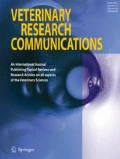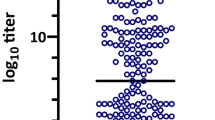Abstract
The influence of age and maternal antibodies on the development and duration of postvaccinal antibody response against Glässer’s disease were investigated. Pigs born to immune (MDA-positive) and non-immune (MDA-negative) sows were vaccinated with inactivated vaccine. Vaccination was done according to three different protocols: at 1 and 4, at 2 and 5 or at 4 and 7 weeks of age. There were also two control groups for MDA-negative and MDA-positive pigs. The level of Haemophilus parasuis (Hps) specific antibodies were determined using commercial ELISA test. No serological responses were seen in any of the groups after the first vaccination. Maternally derived antibodies (MDA) against Hps were above the positive level until approximately 3 weeks of life in MDA-positive pigs. In those pigs the strongest postvaccinal humoral response was observed in piglets vaccinated at 4 and 7 weeks of age. In the remaining MDA-positive piglets only slight seroconversion was noted but levels of antibodies never exceeded values considered as positive. All MDA-negative pigs produced Hps-specific antibodies after the second vaccination. The results of the present study indicated that MDA may alter the development and duration of active postvaccinal antibody response. Age of pigs at the moment of vaccination was not associated with the significant differences in the magnitude of antibody response, however influenced the kinetics of decline of Hps-specific antibodies.

Similar content being viewed by others
References
Bouma A, De Jong MDM, Kimman TG (1998) The influence of maternal immunity on the development of the in vitro lymphocyte proliferation response against pseudorabies virus in pigs. Res Vet Sci 64:167–171
Casal J, Planasdemunt L, Varo JA, Martin M (2004) The use of different vaccination schedules for sows to protect piglets against Aujeszky’s disease. J Vet Med B Infect Dis Vet Public Health 51:8–11
Cerdà-Cuéllar M, Naranjo JF, Verge A, Nofrarias M, Cortey M, Olvera A, Segales J, Aragon V (2010) Sow vaccination modulates the colonization of piglets by haemophilus influenza. Vet Microbiol 145:315–320
de la Fuente AJM, Gutierrez-Martinez CB, Perez Martinez C, Garcia Iglesias MJ, Tejerina F, Rodriguez Ferri EF (2009) Effect of different vaccine formulations on the development of Glassers disease induced in pigs by experimental Haemophilus parasuis infection. J Comp Path 140:169–176
Fischer L, Barzu S, Andreoni Ch, Buisson N, Brun A, Audonnet J (2003) DNA vaccination of neonate piglets in the face of maternal immunity induces humoral memory and protection against a virulent pseudorabies virus challenge. Vaccine 21:1732–1741
Hodgins DC, Shewen PE, Dewey CE (2004) Influence of age and maternal antibodies on antibody responses of neonatal piglets vaccinated against Mycoplasma hyopneumoniae. J Swine Health Prod 12:10–16
Kitchin RP, Salt JS (1995) The interference by maternally-derived antibody with active immunization of farm animals against foot-and-mouth disease. Br Vet J 151:379–389
Oliveira S (2005) Immunity to Haemophilus parasuis. AASV 491–492
Oliveira S, Pijoan C (2004) Haemophilus parasuis: new trends on diagnosis, epidemiology and control. Vet Microbiol 99:1–12
Oliveira S, Galina L, Blanco I, Canals A, Pijoan C (2003) Naturally-farrowed, artificially-reared pigs as an alternative model for experimental infection by Haemophilus parasuis. Can J Vet Res 67:146–150
Oliveira S, Pijoan C, Morrison R (2004) Evaluation of Haemophilus parasuis control in the nursery using vaccination and controlled exposure. J Swine Health Prod 12:123–128
Pomorska-Mól M, Markowska-Daniel I (2010) Interferon-γ secretion and proliferative responses of peripheral blond mononuclear cells after vaccination of pigs against Aujeszky’s disease in the presence of maternal immunity. FEMS Immunol Med Microbiol 58:405–411
Rapp-Gabrielson VJ, Kocur GJ, Clark JT, Muir SK (1997) Haemophilus parasuis: immunity in swine after vaccination. Vet Med 92:83–90
Sadir M, Schudel AA, Laporte O (1988) Response to foot-and-mouth disease vaccines in newborn calves. Influence of age, colostral antibodies and adjuvants. Epidem Inf 100:135–144
Sandbulte MR, Roth JA (2004) Methods for analysis of cell-mediated immunity in domestic animals species. J Am Vet Med Assoc 225:522–530
Siegrist CA (2007) The challenges of vaccine responses in early life: selected examples. J Comp Path 137:4–9
Solano-Aguilar GI, Pijoan C, Rapp-Gabrielson V, Collins J, Carvalho LF, Winkelman N (1999) Protective role of maternal antibodies against Haemophilus parasuis infection. Am J Ves Res 60:81–87
Acknowledgments
This work was supported by Project No NN 308 275934 funded by Ministry of Science and Higher Education (Poland).
Author information
Authors and Affiliations
Corresponding author
Rights and permissions
About this article
Cite this article
Pomorska-Mól, M., Markowska-Daniel, I., Rachubik, J. et al. Effect of maternal antibodies and pig age on the antibody response after vaccination against Glässers disease. Vet Res Commun 35, 337–343 (2011). https://doi.org/10.1007/s11259-011-9478-6
Accepted:
Published:
Issue Date:
DOI: https://doi.org/10.1007/s11259-011-9478-6




